2011 FORD SUPER DUTY reset
[x] Cancel search: resetPage 58 of 90

•Try operating the starter switch several times. Should the switch be
corroded, this operation may clean the contacts or make the switch
temporarily operable until you can reach the dealer.
•If all electrical connections are tight and you need assistance to start,
refer toJump startingin theRoadside Emergencieschapter of your
Owner’s Guide.
If engine cranks but won’t start
Prolonged starter cranking (in excess of 10 seconds) could cause
damage to the starter motor.
•Check the fuel gauge. You may be out of fuel. If the gauge shows that
there is fuel in the tank, the trouble may be in the electrical system or
the fuel system. If equipped with an auxiliary tank, be sure that the
tank control switch is set for the tank with fuel and not on an empty
tank.
•Leaving the ignition key turned to on for over two minutes without
starting may make starting difficult because the glow plugs will cease
activation. Reset the system by turning the ignition key to off and
then back to on again.
If the engine runs hot
The following could cause the engine to overheat:
•Lack of coolant.
•Dirty cooling system.
•Plugged radiator fins, A/C condenser and/or oil cooler.
•Malfunctioning fan drive.
•Driving with frozen coolant.
•Sticking thermostat.
•Overloading or pulling heavy trailers during hot weather.
•Grill or radiator air blockage.
•Slipping or missing drive belt.
•Plugged or very dirty air filter.
Maintenance and Specifications
58
2011 Econoline(eco)
Supplement, 1st Printing
USA(fus)
Page 63 of 90
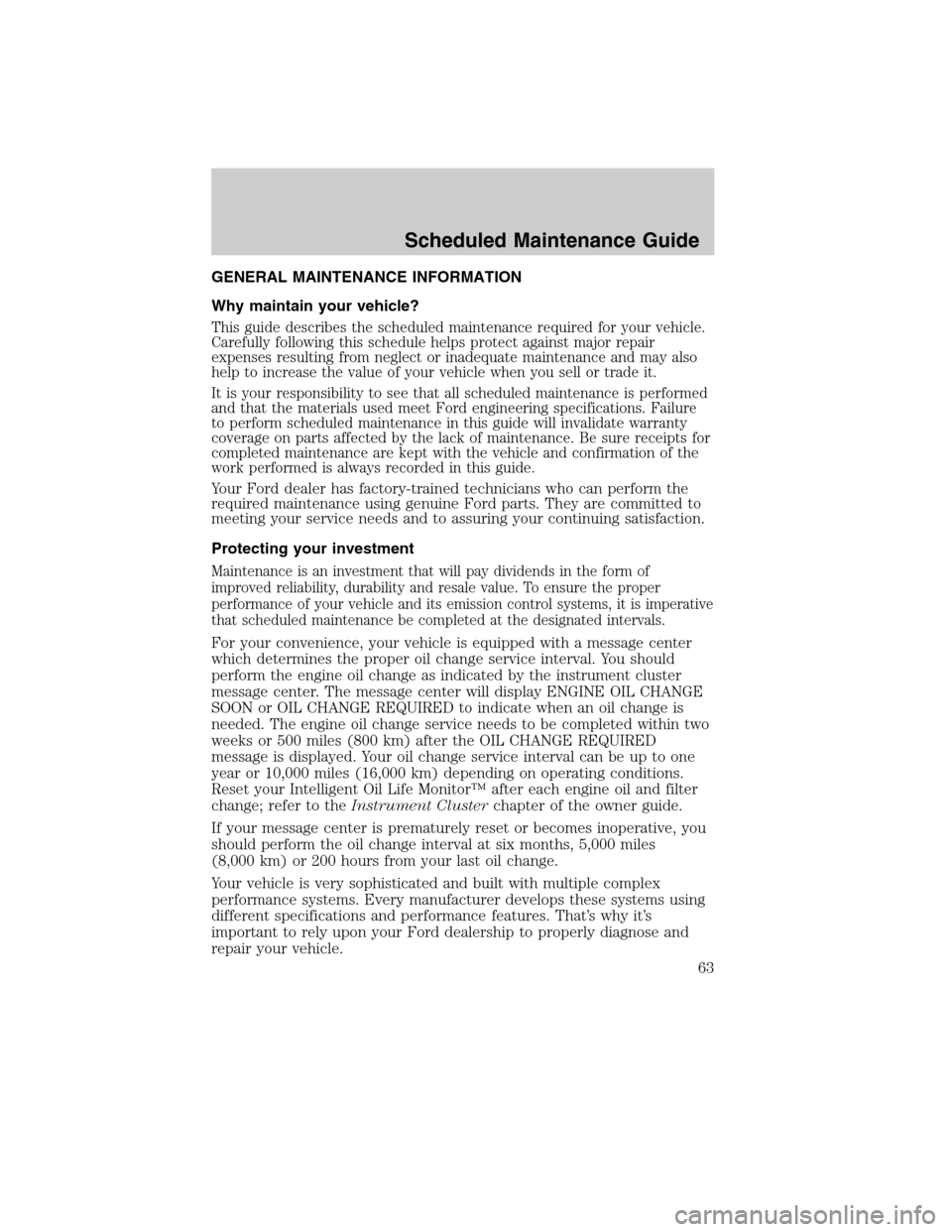
GENERAL MAINTENANCE INFORMATION
Why maintain your vehicle?
This guide describes the scheduled maintenance required for your vehicle.
Carefully following this schedule helps protect against major repair
expenses resulting from neglect or inadequate maintenance and may also
help to increase the value of your vehicle when you sell or trade it.
It is your responsibility to see that all scheduled maintenance is performed
and that the materials used meet Ford engineering specifications. Failure
to perform scheduled maintenance in this guide will invalidate warranty
coverage on parts affected by the lack of maintenance. Be sure receipts for
completed maintenance are kept with the vehicle and confirmation of the
work performed is always recorded in this guide.
Your Ford dealer has factory-trained technicians who can perform the
required maintenance using genuine Ford parts. They are committed to
meeting your service needs and to assuring your continuing satisfaction.
Protecting your investment
Maintenance is an investment that will pay dividends in the form of
improved reliability, durability and resale value. To ensure the proper
performance of your vehicle and its emission control systems, it is imperative
that scheduled maintenance be completed at the designated intervals.
For your convenience, your vehicle is equipped with a message center
which determines the proper oil change service interval. You should
perform the engine oil change as indicated by the instrument cluster
message center. The message center will display ENGINE OIL CHANGE
SOON or OIL CHANGE REQUIRED to indicate when an oil change is
needed. The engine oil change service needs to be completed within two
weeks or 500 miles (800 km) after the OIL CHANGE REQUIRED
message is displayed. Your oil change service interval can be up to one
year or 10,000 miles (16,000 km) depending on operating conditions.
Reset your Intelligent Oil Life Monitor™ after each engine oil and filter
change; refer to theInstrument Clusterchapter of the owner guide.
If your message center is prematurely reset or becomes inoperative, you
should perform the oil change interval at six months, 5,000 miles
(8,000 km) or 200 hours from your last oil change.
Your vehicle is very sophisticated and built with multiple complex
performance systems. Every manufacturer develops these systems using
different specifications and performance features. That’s why it’s
important to rely upon your Ford dealership to properly diagnose and
repair your vehicle.
Scheduled Maintenance Guide
63
2011 Econoline(eco)
Supplement, 1st Printing
USA(fus)
Page 67 of 90
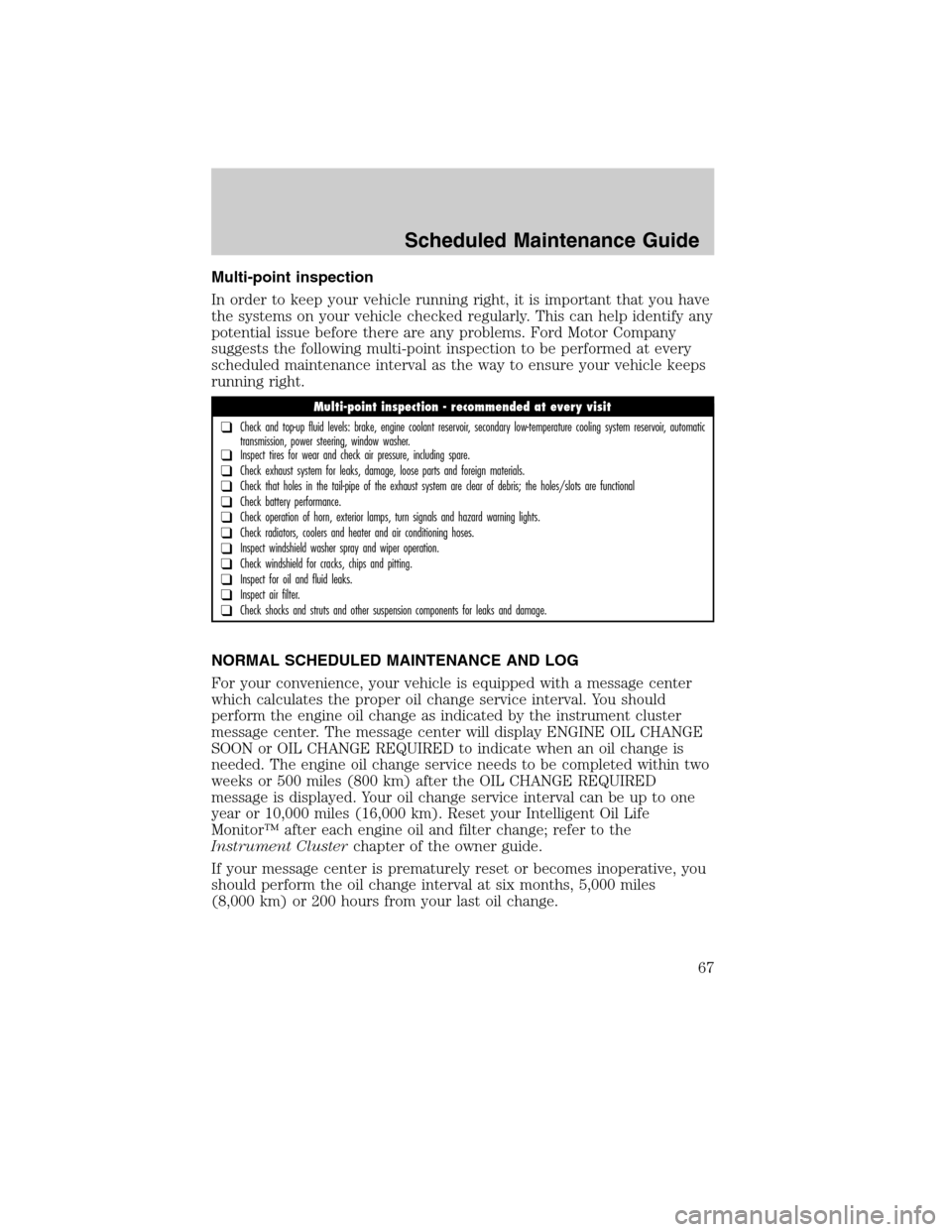
Multi-point inspection
In order to keep your vehicle running right, it is important that you have
the systems on your vehicle checked regularly. This can help identify any
potential issue before there are any problems. Ford Motor Company
suggests the following multi-point inspection to be performed at every
scheduled maintenance interval as the way to ensure your vehicle keeps
running right.
NORMAL SCHEDULED MAINTENANCE AND LOG
For your convenience, your vehicle is equipped with a message center
which calculates the proper oil change service interval. You should
perform the engine oil change as indicated by the instrument cluster
message center. The message center will display ENGINE OIL CHANGE
SOON or OIL CHANGE REQUIRED to indicate when an oil change is
needed. The engine oil change service needs to be completed within two
weeks or 500 miles (800 km) after the OIL CHANGE REQUIRED
message is displayed. Your oil change service interval can be up to one
year or 10,000 miles (16,000 km). Reset your Intelligent Oil Life
Monitor™ after each engine oil and filter change; refer to the
Instrument Clusterchapter of the owner guide.
If your message center is prematurely reset or becomes inoperative, you
should perform the oil change interval at six months, 5,000 miles
(8,000 km) or 200 hours from your last oil change.
Multi-point inspection - recommended at every visit
❑Check and top-up fluid levels: brake, engine coolant reservoir, secondary low-temperature cooling system reservoir, automatic
transmission, power steering, window washer.
❑Inspect tires for wear and check air pressure, including spare.
❑Check exhaust system for leaks, damage, loose parts and foreign materials.
❑Check that holes in the tail-pipe of the exhaust system are clear of debris; the holes/slots are functional
❑Check battery performance.
❑Check operation of horn, exterior lamps, turn signals and hazard warning lights.
❑Check radiators, coolers and heater and air conditioning hoses.
❑Inspect windshield washer spray and wiper operation.
❑Check windshield for cracks, chips and pitting.
❑Inspect for oil and fluid leaks.
❑Inspect air filter.
❑Check shocks and struts and other suspension components for leaks and damage.
Scheduled Maintenance Guide
67
2011 Econoline(eco)
Supplement, 1st Printing
USA(fus)
Page 69 of 90
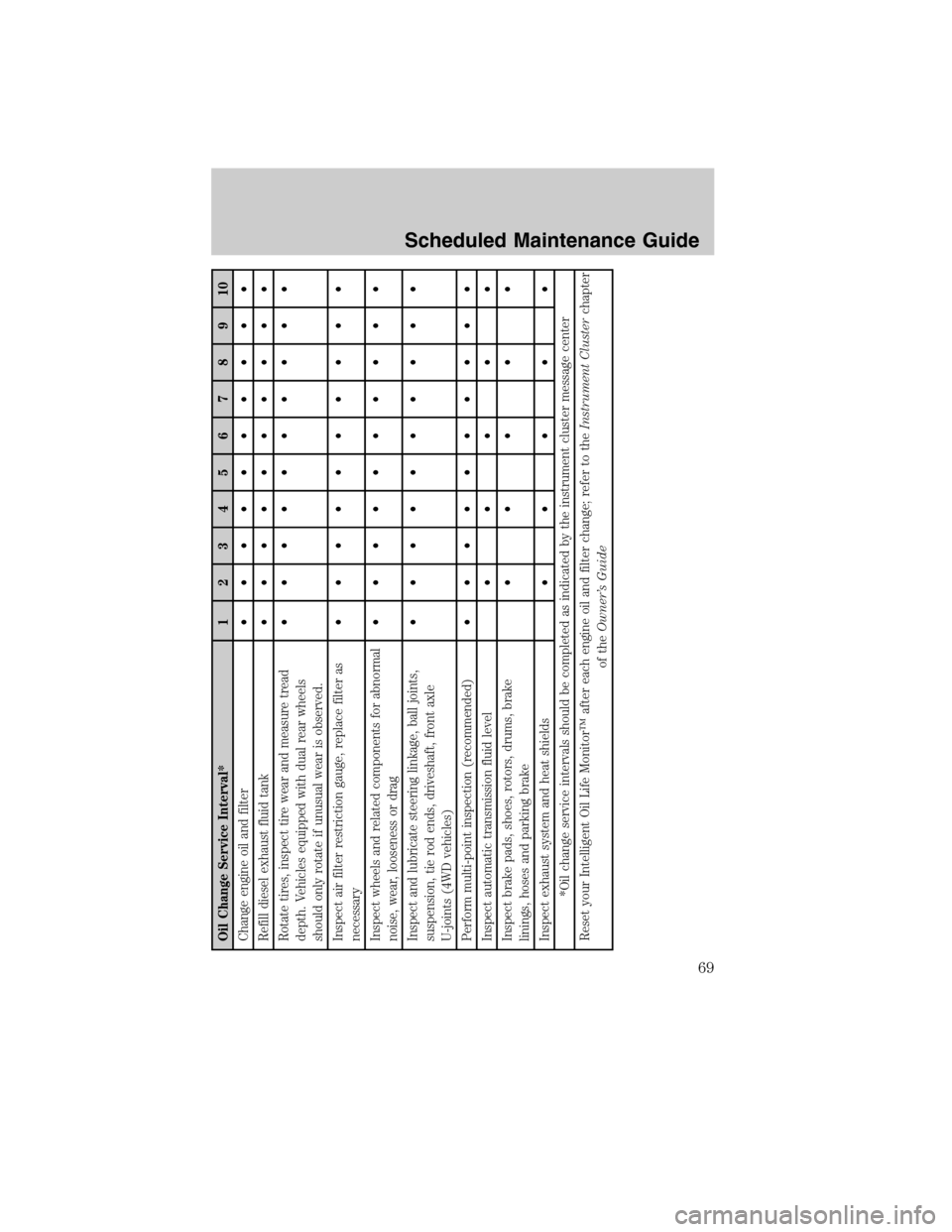
Oil Change Service Interval* 1 2 345678910
Change engine oil and filter• •••••••••
Refill diesel exhaust fluid tank• •••••••••
Rotate tires, inspect tire wear and measure tread
depth. Vehicles equipped with dual rear wheels
should only rotate if unusual wear is observed.• •••••••••
Inspect air filter restriction gauge, replace filter as
necessary• •••••••••
Inspect wheels and related components for abnormal
noise, wear, looseness or drag• •••••••••
Inspect and lubricate steering linkage, ball joints,
suspension, tie rod ends, driveshaft, front axle
U-joints (4WD vehicles)• •••••••••
Perform multi-point inspection (recommended)• •••••••••
Inspect automatic transmission fluid level•••••
Inspect brake pads, shoes, rotors, drums, brake
linings, hoses and parking brake•••••
Inspect exhaust system and heat shields•••••
*Oil change service intervals should be completed as indicated by the instrument cluster message center
Reset your Intelligent Oil Life Monitor™ after each engine oil and filter change; refer to theInstrument Clusterchapter
of theOwner’s Guide
Scheduled Maintenance Guide
69
2011 Econoline(eco)
Supplement, 1st Printing
USA(fus)
Page 70 of 90
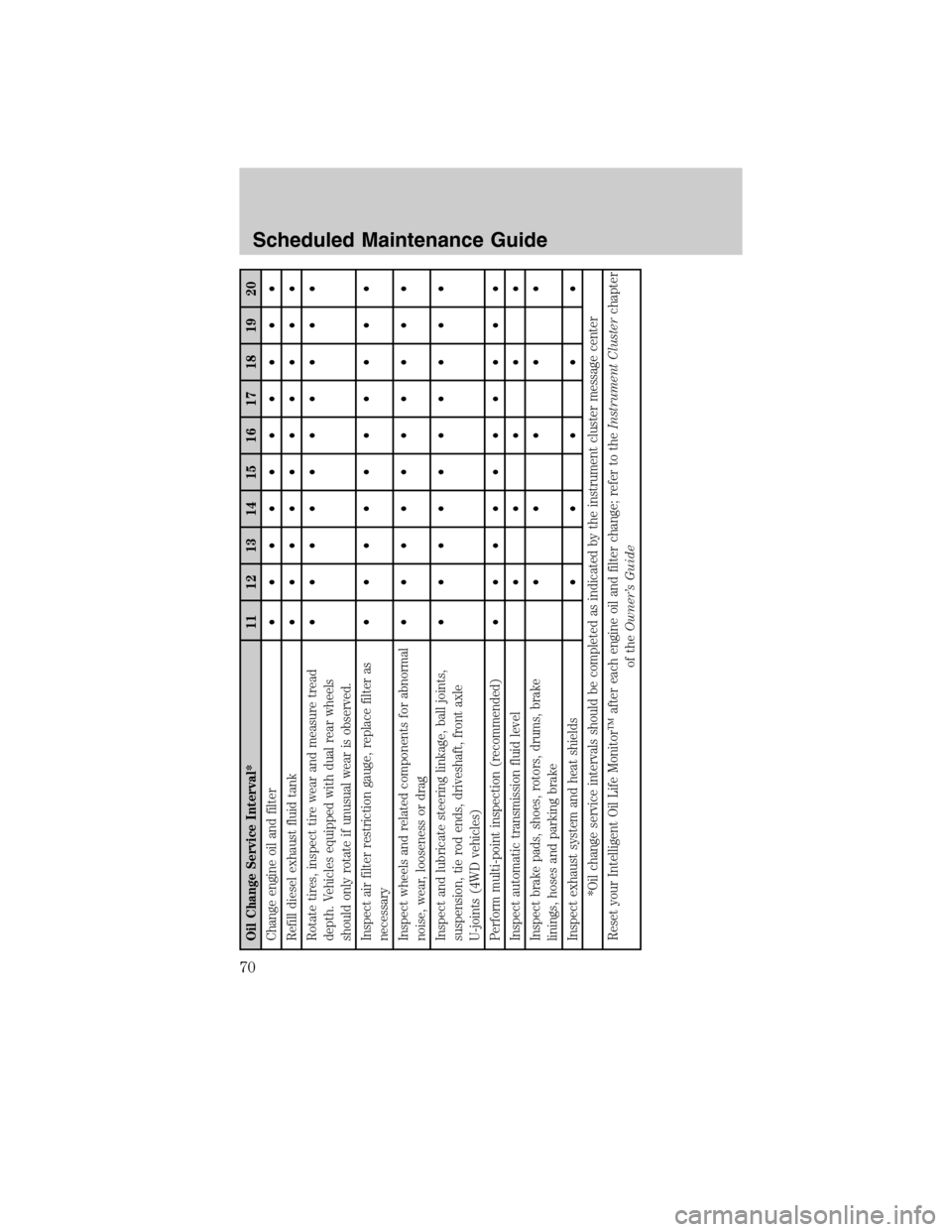
Oil Change Service Interval* 11 12 13 14 15 16 17 18 19 20
Change engine oil and filter• •••••••••
Refill diesel exhaust fluid tank• •••••••••
Rotate tires, inspect tire wear and measure tread
depth. Vehicles equipped with dual rear wheels
should only rotate if unusual wear is observed.• •••••••••
Inspect air filter restriction gauge, replace filter as
necessary• •••••••••
Inspect wheels and related components for abnormal
noise, wear, looseness or drag• •••••••••
Inspect and lubricate steering linkage, ball joints,
suspension, tie rod ends, driveshaft, front axle
U-joints (4WD vehicles)• •••••••••
Perform multi-point inspection (recommended)• •••••••••
Inspect automatic transmission fluid level•••••
Inspect brake pads, shoes, rotors, drums, brake
linings, hoses and parking brake•••••
Inspect exhaust system and heat shields•••••
*Oil change service intervals should be completed as indicated by the instrument cluster message center
Reset your Intelligent Oil Life Monitor™ after each engine oil and filter change; refer to theInstrument Clusterchapter
of theOwner’s Guide
Scheduled Maintenance Guide
70
2011 Econoline(eco)
Supplement, 1st Printing
USA(fus)
Page 71 of 90
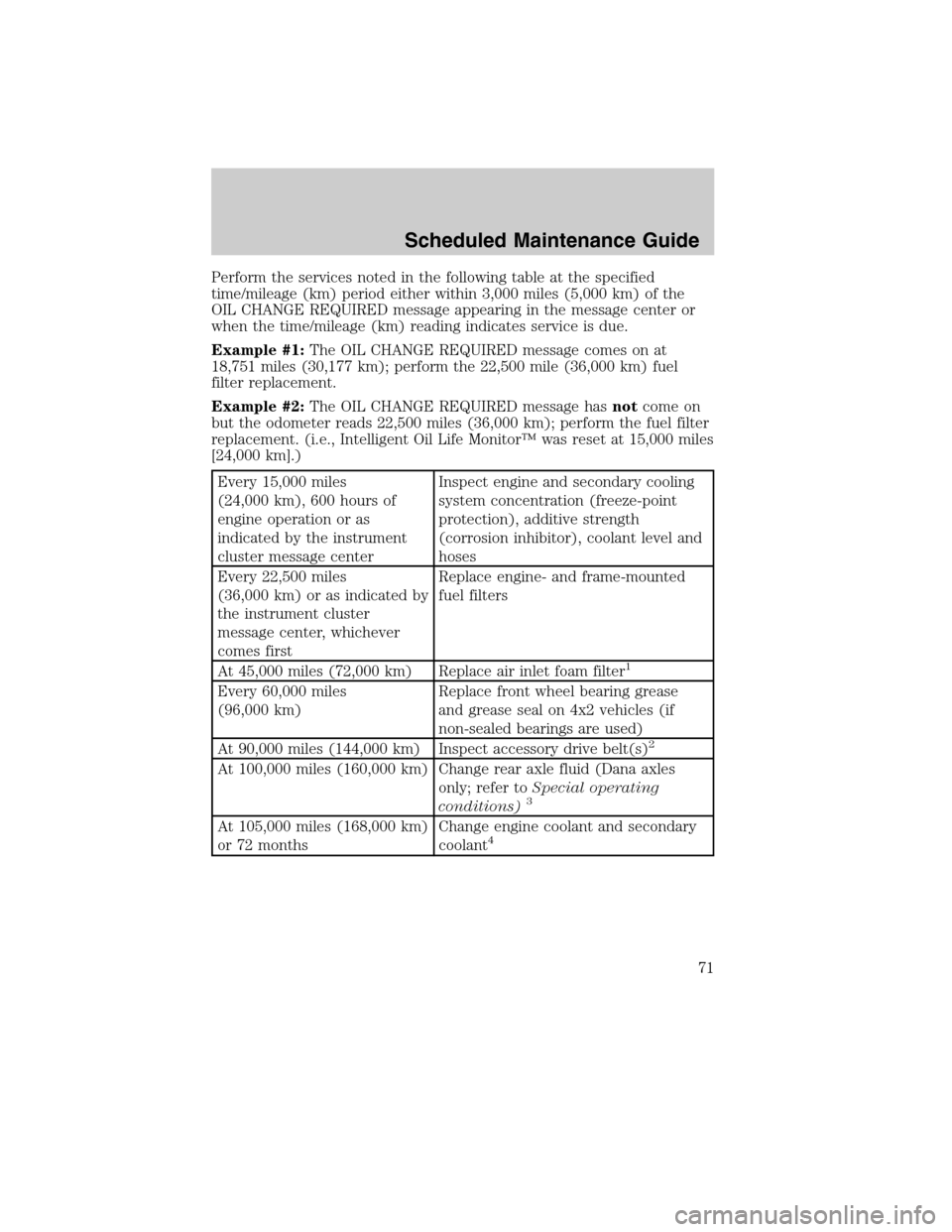
Perform the services noted in the following table at the specified
time/mileage (km) period either within 3,000 miles (5,000 km) of the
OIL CHANGE REQUIRED message appearing in the message center or
when the time/mileage (km) reading indicates service is due.
Example #1:The OIL CHANGE REQUIRED message comes on at
18,751 miles (30,177 km); perform the 22,500 mile (36,000 km) fuel
filter replacement.
Example #2:The OIL CHANGE REQUIRED message hasnotcome on
but the odometer reads 22,500 miles (36,000 km); perform the fuel filter
replacement. (i.e., Intelligent Oil Life Monitor™ was reset at 15,000 miles
[24,000 km].)
Every 15,000 miles
(24,000 km), 600 hours of
engine operation or as
indicated by the instrument
cluster message centerInspect engine and secondary cooling
system concentration (freeze-point
protection), additive strength
(corrosion inhibitor), coolant level and
hoses
Every 22,500 miles
(36,000 km) or as indicated by
the instrument cluster
message center, whichever
comes firstReplace engine- and frame-mounted
fuel filters
At 45,000 miles (72,000 km) Replace air inlet foam filter
1
Every 60,000 miles
(96,000 km)Replace front wheel bearing grease
and grease seal on 4x2 vehicles (if
non-sealed bearings are used)
At 90,000 miles (144,000 km) Inspect accessory drive belt(s)
2
At 100,000 miles (160,000 km) Change rear axle fluid (Dana axles
only; refer toSpecial operating
conditions)
3
At 105,000 miles (168,000 km)
or 72 monthsChange engine coolant and secondary
coolant4
Scheduled Maintenance Guide
71
2011 Econoline(eco)
Supplement, 1st Printing
USA(fus)
Page 76 of 90
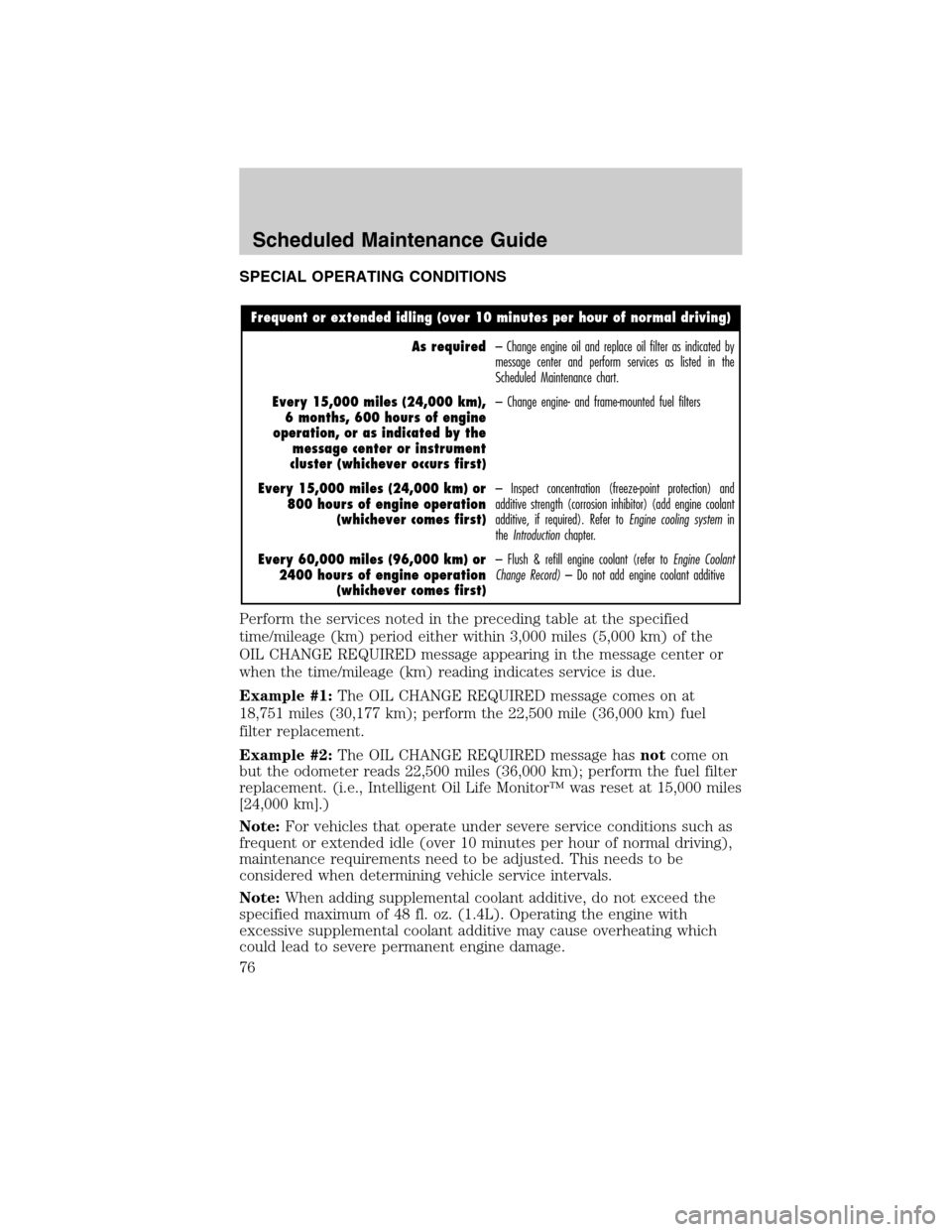
SPECIAL OPERATING CONDITIONS
Frequent or extended idling (over 10 minutes per hour of normal driving)
As required– Change engine oil and replace oil filter as indicated by
message center and perform services as listed in the
Scheduled Maintenance chart.
Every 15,000 miles (24,000 km),
6 months, 600 hours of engine
operation, or as indicated by the
message center or instrument
cluster (whichever occurs first)– Change engine- and frame-mounted fuel filters
Every 15,000 miles (24,000 km) or
800 hours of engine operation
(whichever comes first)– Inspect concentration (freeze-point protection) and
additive strength (corrosion inhibitor) (add engine coolant
additive, if required). Refer to
Engine cooling systemin
theIntroductionchapter.
Every 60,000 miles (96,000 km) or
2400 hours of engine operation
(whichever comes first)– Flush & refill engine coolant (refer to
Engine Coolant
Change Record)– Do not add engine coolant additive
Perform the services noted in the preceding table at the specified
time/mileage (km) period either within 3,000 miles (5,000 km) of the
OIL CHANGE REQUIRED message appearing in the message center or
when the time/mileage (km) reading indicates service is due.
Example #1:The OIL CHANGE REQUIRED message comes on at
18,751 miles (30,177 km); perform the 22,500 mile (36,000 km) fuel
filter replacement.
Example #2:The OIL CHANGE REQUIRED message hasnotcome on
but the odometer reads 22,500 miles (36,000 km); perform the fuel filter
replacement. (i.e., Intelligent Oil Life Monitor™ was reset at 15,000 miles
[24,000 km].)
Note:For vehicles that operate under severe service conditions such as
frequent or extended idle (over 10 minutes per hour of normal driving),
maintenance requirements need to be adjusted. This needs to be
considered when determining vehicle service intervals.
Note:When adding supplemental coolant additive, do not exceed the
specified maximum of 48 fl. oz. (1.4L). Operating the engine with
excessive supplemental coolant additive may cause overheating which
could lead to severe permanent engine damage.
Scheduled Maintenance Guide
76
2011 Econoline(eco)
Supplement, 1st Printing
USA(fus)
Page 77 of 90
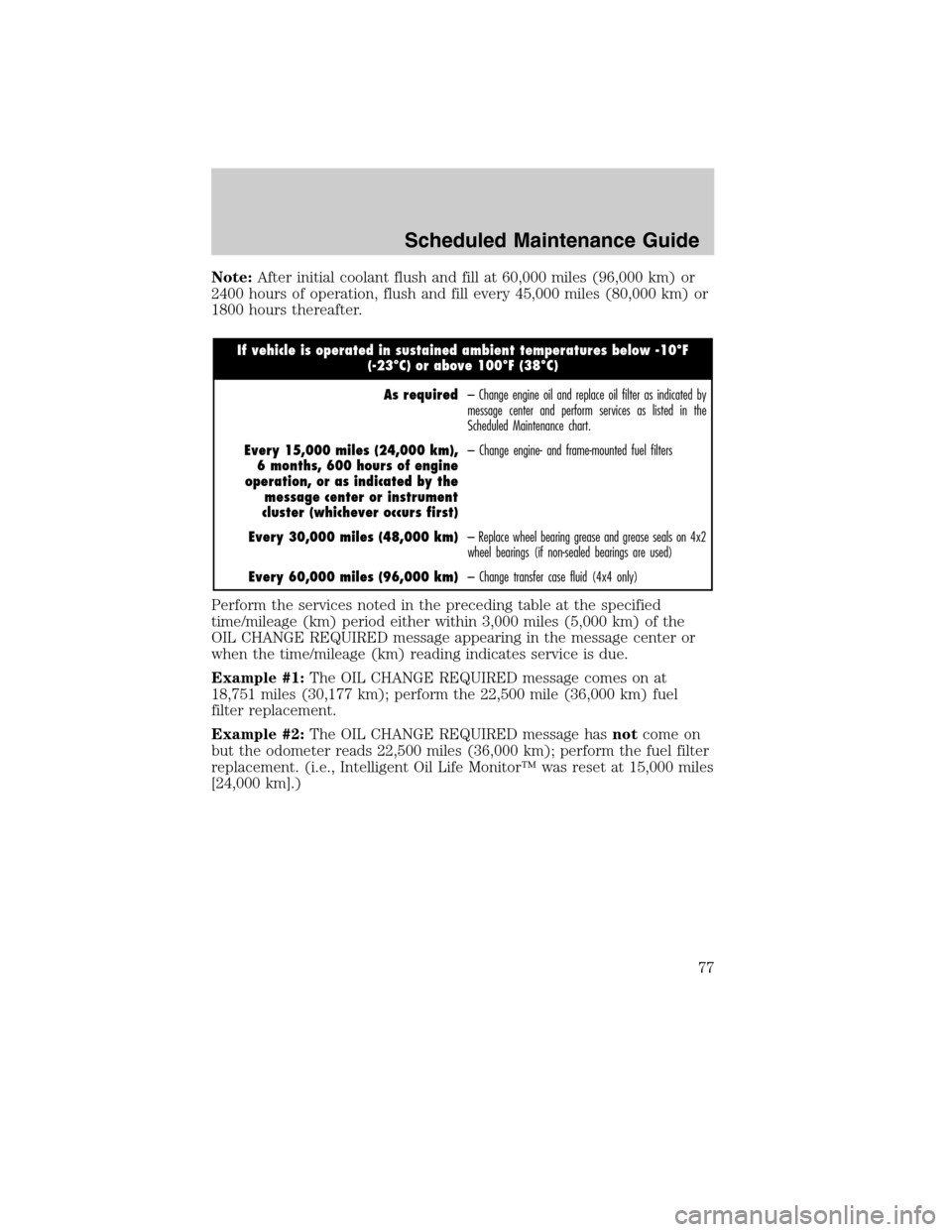
Note:After initial coolant flush and fill at 60,000 miles (96,000 km) or
2400 hours of operation, flush and fill every 45,000 miles (80,000 km) or
1800 hours thereafter.
If vehicle is operated in sustained ambient temperatures below -10°F
(-23°C) or above 100°F (38°C)
As required– Change engine oil and replace oil filter as indicated by
message center and perform services as listed in the
Scheduled Maintenance chart.
Every 15,000 miles (24,000 km),
6 months, 600 hours of engine
operation, or as indicated by the
message center or instrument
cluster (whichever occurs first)– Change engine- and frame-mounted fuel filters
Every 30,000 miles (48,000 km)– Replace wheel bearing grease and grease seals on 4x2
wheel bearings (if non-sealed bearings are used)
Every 60,000 miles (96,000 km)– Change transfer case fluid (4x4 only)
Perform the services noted in the preceding table at the specified
time/mileage (km) period either within 3,000 miles (5,000 km) of the
OIL CHANGE REQUIRED message appearing in the message center or
when the time/mileage (km) reading indicates service is due.
Example #1:The OIL CHANGE REQUIRED message comes on at
18,751 miles (30,177 km); perform the 22,500 mile (36,000 km) fuel
filter replacement.
Example #2:The OIL CHANGE REQUIRED message hasnotcome on
but the odometer reads 22,500 miles (36,000 km); perform the fuel filter
replacement. (i.e., Intelligent Oil Life Monitor™ was reset at 15,000 miles
[24,000 km].)
Scheduled Maintenance Guide
77
2011 Econoline(eco)
Supplement, 1st Printing
USA(fus)